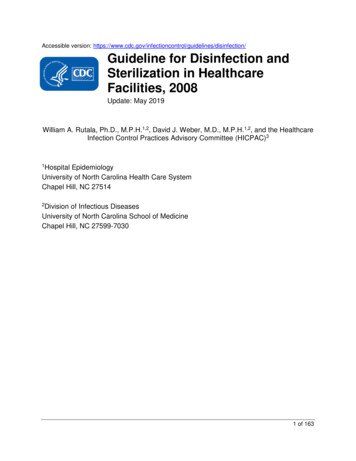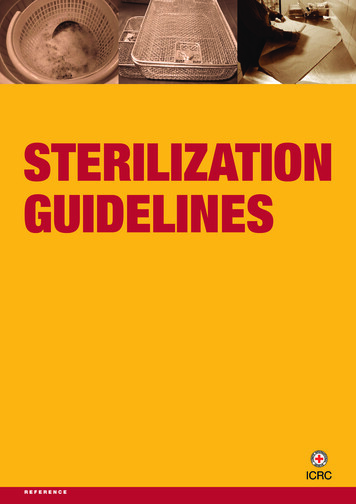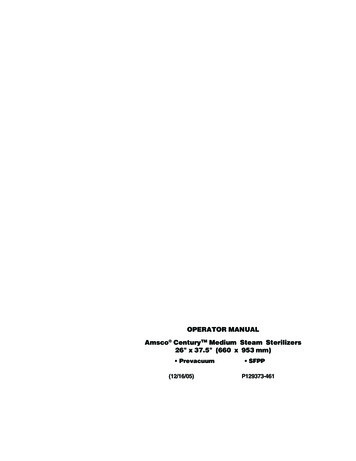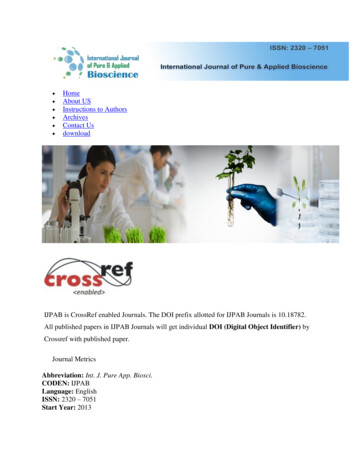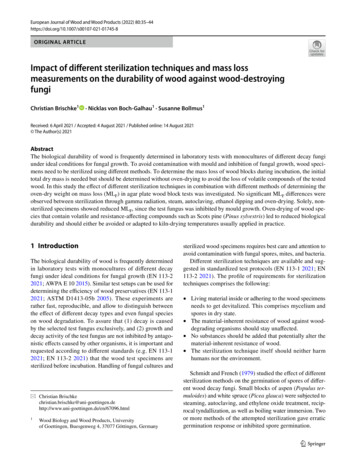
Transcription
European Journal of Wood and Wood Products (2022) -8ORIGINAL ARTICLEImpact of different sterilization techniques and mass lossmeasurements on the durability of wood against wood‑destroyingfungiChristian Brischke1· Nicklas von Boch‑Galhau1 · Susanne Bollmus1Received: 6 April 2021 / Accepted: 4 August 2021 / Published online: 14 August 2021 The Author(s) 2021AbstractThe biological durability of wood is frequently determined in laboratory tests with monocultures of different decay fungiunder ideal conditions for fungal growth. To avoid contamination with mould and inhibition of fungal growth, wood specimens need to be sterilized using different methods. To determine the mass loss of wood blocks during incubation, the initialtotal dry mass is needed but should be determined without oven-drying to avoid the loss of volatile compounds of the testedwood. In this study the effect of different sterilization techniques in combination with different methods of determining theoven-dry weight on mass loss ( MLF) in agar plate wood block tests was investigated. No significant M LF differences wereobserved between sterilization through gamma radiation, steam, autoclaving, ethanol dipping and oven-drying. Solely, nonsterilized specimens showed reduced MLF, since the test fungus was inhibited by mould growth. Oven-drying of wood species that contain volatile and resistance-affecting compounds such as Scots pine (Pinus sylvestris) led to reduced biologicaldurability and should either be avoided or adapted to kiln-drying temperatures usually applied in practice.1 IntroductionThe biological durability of wood is frequently determinedin laboratory tests with monocultures of different decayfungi under ideal conditions for fungal growth (EN 113-22021; AWPA E 10 2015). Similar test setups can be used fordetermining the efficiency of wood preservatives (EN 113-12021; ASTM D1413-05b 2005). These experiments arerather fast, reproducible, and allow to distinguish betweenthe effect of different decay types and even fungal specieson wood degradation. To assure that (1) decay is causedby the selected test fungus exclusively, and (2) growth anddecay activity of the test fungus are not inhibited by antagonistic effects caused by other organisms, it is important andrequested according to different standards (e.g. EN 113-12021; EN 113-2 2021) that the wood test specimens aresterilized before incubation. Handling of fungal cultures and* Christian /www.uni-goettingen.de/en/67096.html1Wood Biology and Wood Products, Universityof Goettingen, Buesgenweg 4, 37077 Göttingen, Germanysterilized wood specimens requires best care and attention toavoid contamination with fungal spores, mites, and bacteria.Different sterilization techniques are available and suggested in standardized test protocols (EN 113-1 2021; EN113-2 2021). The profile of requirements for sterilizationtechniques comprises the following: Living material inside or adhering to the wood specimensneeds to get devitalized. This comprises mycelium andspores in dry state. The material-inherent resistance of wood against wooddegrading organisms should stay unaffected. No substances should be added that potentially alter thematerial-inherent resistance of wood. The sterilization technique itself should neither harmhumans nor the environment.Schmidt and French (1979) studied the effect of differentsterilization methods on the germination of spores of different wood decay fungi. Small blocks of aspen (Populus termuloides) and white spruce (Picea glauca) were subjected tosteaming, autoclaving, and ethylene oxide treatment, reciprocal tyndallization, as well as boiling water immersion. Twoor more methods of the attempted sterilization gave erraticgermination response or inhibited spore germination.13Vol.:(0123456789)
36In the past, sterilization with hot steam and gaseous pesticides (fumigants, e.g. bromine methane andmonophosphane) has been common practice (Armstronget al. 2014), but the latter was banned from laboratorypractice due to health risk issues. Therefore, today steamtreatments and gamma irradiation are the most commonsterilization methods and recommended for instance in EN113-1 (2021) and EN 113-2 (2021).Heat sterilization is used worldwide and currently themost practical and environmentally friendly treatment tokill pests in solid wood materials (Wang 2010). Treatment schedule requirements differ between countries anddepend on the type and size of objects that are traded andtherefore transported. The International Standard for Phytosanitary Measures (ISPM) ‘Guidelines for RegulatingWood Packaging Material in International Trade’ requiresheating wood to a minimum core temperature of 56 Cfor a minimum of 30 min (IPPC 2002; APHIS 2004). Forsterilizing wood specimens for biological durability tests,higher temperatures are applied such as under hot steam(EN 113-1 2021; EN 113-2 2021). Wang (2010) reviewedfactors affecting the heating time needed to achieve a fullysterile substrate. Accordingly, the energy source, the typeand circulation of the heating medium, the size and configuration of wood, the wood species, corresponding woodproperties, and the type of stacking wood samples do significantly affect the efficacy of heat treatments.Smith and Sharman (1971) reported on a steam sterilization at 121 C for 30 min leading to fully effective sterilisation of ponderosa pine (Pinus ponderosa) and red alder(Alnus rubra) sapwood blocks without significant effect onmass loss by different decay fungi in subsequent incubation experiment. Chapman (1933) compared the effect ofdifferent steam treatments on the susceptibility of greenloblolly pine (Pinus taeda) sapwood to wood-destroyingfungi. He concluded that steam sterilization, especiallywith pressure and resultant higher temperatures, mightmake the wood more susceptible to fungal decay after thefungus has passed the earliest invasion stage.Kacik et al. (2016) sterilized Scots pine (Pinus sylvestris) sapwood at 120 C under atmospheric pressure andfound an increase in the percentage of extractives and theamount of dioxane lignin yields compared to untreated woodwhile a decrease in the acid-insoluble lignin content wasalso observed. Based on FTIR studies they suggested that acleavage of ether bonds and α- and β-alkyl-aryl ether bondstook place.Gamma radiation has been shown to be effective to prevent mold growth on wood (Scheffer 1963; Hansen 1972).Freitag and Morrell (1998) showed that a 60Co dosage of15 kGy efficiently sterilized ponderosa pine sapwood wafers.However, according to different test standards, a higher dosage is required, for example 25–50 kGy when using a 60Co13European Journal of Wood and Wood Products (2022) 80:35–44source and 50–100 kGy when a neutron accelerator is used(EN 113-1 2021; EN 113-2 2021).Several previous studies focused on the effect of gammairradiation on the biological durability of wood, but cameto partly contradictory results and conclusions: Katsumataet al. (2007) found that the degree of polymerization of cellulose adversely decreased with increasing doses of gammairradiation. Furthermore, termite wood consumption rateswere significantly higher at 100 kGy than at lower doses.On the other hand, the decay resistance of gamma-irradiatedwood against the fungi Fomitopsis palustris and Trametesversicolor was not affected by irradiation dose in a rangebetween 0 and 100 kGy. In contrast, Hasan et al. (2008)showed that gamma radiation significantly affected decayof Scots pine sapwood after incubation with Poria placenta.Mass loss was increased by 20% and 68% when the woodblocks were sterilized at 30 kGy and 150 kGy respectively,using a 60Co source compared to autoclaved referencespecimens.Curling and Winandy (2008) examined the effect ofgamma radiation on mass and flexural bending strengthof Southern pine sapwood (Pinus spp.) in a range between15 and 75 kGy. Bending strength decreased with increasing total dosage and dose rate (8.5–16.9 kGy/h) and it wasconcluded that when total gamma-irradiation dosage wasdirectly compared at or near the critical levels required toachieve sterilization, shorter applications using higher doserates had less effect on strength than longer applicationsusing lower dose rates. Consequently, gamma radiationwould have at least an indirect effect on the classification ofbiological durability when loss in bending strength or modulus of elasticity are considered (e.g. CEN/TS 15083-2 2005).Sharman and Smith (1971) found that the lethal radiationdose depends on the wood moisture content (MC) and eventually also on the concentration of microorganisms in thewood. However, a radiation dose of 10–50 kGy (60Co) wassufficient to kill all organisms in cubes (19 19 19 mm3)of ponderosa pine and birch (Betula sp.) sapwood. Furthermore, they found that there is no obvious aftereffect,resulting in an increased efficiency of killing of microorganisms with time, i.e. no hindered growth of microorganismsafter unsterile conditioning afterwards. In a second study,Smith and Sharman (1971) examined the potential effectsof gamma, wet-heat, and ethylene oxide treatments on subsequent decay of ponderosa pine and red alder sapwood.Solely after gamma radiation at 100 kGy, decay by Poriaweirii increased slightly, but significantly.Smith (1965) used methyl alcohol, propylene oxide andethylene oxide to sterilize both Scots pine sapwood andEuropean beech (Fagus sylvatica) wood blocks, whereethylene oxide was the most efficient sterilizing agent andmethyl alcohol the least effective. However, toxic residuesremaining in the wood blocks after sterilizing and ventilating
European Journal of Wood and Wood Products (2022) 80:35–44treatment with propylene oxide seriously inhibited the subsequent growth of Lentinus lepideus. Ethylene oxide wasalso used by Smith and Sharman (1971) and was found tobe highly efficient for sterilization.Da Costa and Osborne (1970) observed toxic residualeffects which may influence the results of decay tests whenpropylene oxide is used for sterilization and therefore recommended heat-sterilization. Grinda (1984) incubateduntreated and preservative treated Scots pine sapwoodspecimens after sterilizing with three different methods: (1)sterilization in a steam pot at 100 C for 10 min on twosubsequent days, (2) ethylene oxide treatment in vacuumduring 60 min at 55 C and subsequent laminar ventilationfor 5 days, and (3) gamma radiation at 30 kGy. Results ofsubsequent decay tests with untreated wood were not significantly different between steam-treated and the ethyleneoxide treated specimens. However, mass loss of preservativetreated specimens was affected by previous ethylene oxidesterilization. Gamma treatment did not affect the decay testresults with treated wood specimens.Mass loss due to fungal decay is usually calculated basedon the oven-dry mass of the test specimens before and afterincubation with wood-destroying fungi (EN 113-1 2021;EN 113-2 2021). However, the oven-dry mass should notbe determined by oven-drying of the test specimens. Instead,additional moisture control specimens are dried after theyhad been conditioned in normal climate, i.e. at 20 C/65%relative humidity (RH), together with the test specimens.The theoretical oven-dry mass of the test specimens is calculated based on the equilibrium moisture content (EMC)of the moisture control specimens (see also Eq. 3) assumingthat both, EMC of moisture control specimens and test specimens, are identic. The EMC of wood can vary significantlywithin a wood species (Hernández 2007; Alfredsen et al.2021) and even within a single tree (Hill et al. 2015). Consequently, the use of moisture control specimens is attributedTable 1 Hypothesized effectsof different treatments usedfor sterilization, pre-ageing,and determination of oven-dryweights of specimens in wooddurability testsTreatment37to systematic mistakes, whose amplitude depends on thewood species, the sampling procedure, and the variation oftreatment intensity of modified or otherwise treated timbers(Zhou et al. 2013).Oven-drying of test specimens might affect the resultsof durability tests since volatile organic compounds evaporate from the tested material at elevated temperatures. Suchcompounds are usually efficient against wood-destroyingorganisms, such as resins or terpenoids (Taylor et al. 2002),or may be easily accessible food sources subtracted fromthe substrate before the test begins, such as soluble carbohydrates. Both ways, the mass loss caused by fungal decaycan be affected, especially when the test specimens undergoa leaching procedure prior to incubation.The negative effect of oven-drying on the durability ofdifferent hardwood and softwood species against wooddestroying fungi was shown in different studies by Bavendamm (1941, 1943), where both the mass loss of the testedwood and of the tested reference wood can be affected. Scotspine sapwood, that served as reference and virulence controlin different European standard tests (e.g. EN 113-1 2021; EN113-2 2021; ENV 807 2001), contains pinosylvin, which hasan inhibitory effect on fungal growth (Celimene et al. 1999)but evaporates at elevated temperatures.This study aimed at examining the effects of differentsterilization techniques and methods to determine the ovendry mass of wood specimens on their durability againstobligatory standard test fungi. It was hypothesized thatsterilization, for example by gamma irradiation, can lead toa physical pre-degradation of cell wall components and/orwood ingredients which may have a negative effect on thebiological durability of wood. Similarly, high temperaturesduring oven-drying, steam and autoclave sterilization maynegatively affect wood durability since volatile compoundsmay evaporate from the wood (Table 1). Since such potentially negative effects apply to both the wood material underHypothesized effects on fungal decay of wood test specimensPositiveGamma sterilization Formation of free radicals leading to cleavageof hydrogen bonds, increased accessibility ofcellulose and hemicellulose moleculesFumigants (e.g. bro- –mine methane)AutoclavingLoss of volatile inhibiting substances, e.g.resins, and cleavage of bonds, e.g. α- andSteam treatmentβ-alkyl-aryl ether bonds in lignin, leading toOven-dryinghigher accessibilityAlcohol–LeachingLoss of inhibitory substancesNone–Negative–Toxic residual effects––Loss of easily accessible substancesContamination with non-targetorganisms, antagonistic effects13
38European Journal of Wood and Wood Products (2022) 80:35–44test and the respective non-durable reference wood species,consequences on durability classification should also beanalysed.2 Materials and methodsSpecimens of 15 25 50 (ax.) mm3 were prepared fromScots pine sapwood and heartwood (Pinus sylvestris L.),European beech (Fagus sylvatica L.), and English oak heartwood (Quercus robur L.) according to CEN/TS 15083-1(2005) and EN 113-2 (2021). All specimens were free fromdefects such as cracks, knots, resin pockets, discolorationand decay. They were cut from single stems to reduce theeffect of intra-species variation in material resistance. Treeswere harvested in Lower Saxony nearby the city of Goettingen, and cut into boards, which were air-dried beforespecimen preparation. In total, 1120 decay test specimenswere made, evenly assigned to different methods of sterilization and oven-dry mass determination, and n 10 replicatespecimens were used for each combination. All specimenswere pre-aged according to EN 84 (2020), and thereforesubmerged in deionized water in plastic containers. After avacuum impregnation at 4 kPa during 20 min, the specimenswere kept submerged and the water was exchanged ten timesduring 14 days. After the leaching procedure, the specimenswere carefully dried.2.2 Determination of oven‑dry massThe oven-dry mass of the specimens was determined usingeither the oven-drying method (ODM) or the moisture equilibrium method (MEM). Half of the specimens was assignedto each of the methods. Firstly, all specimens were conditioned at 20 C/65% RH until constant mass was achieved.Half of the specimens assigned to the different sterilizationmethods was oven-dried at 103 2 C for 48 h and weighedto the nearest 0.001 g. The wood moisture content (MC) ofthe oven-dried wood specimens was calculated accordingto Eq. 1. The theoretical oven-dry mass ( m0,th) of the second half of the specimens, which had not been dried, wascalculated using the mean wood MC of the correspondingspecimen sets from the first half according to Eq. 2.Equation 1: Calculation of wood moisture content MC:mc m0,Lm0,L13 100 [%]Equation 2: Calculation of theoretical oven-dry mass m0,th:m0,th 2.1 Wood specimensMC m c mass after conditioning at 20 C/65% RH [g]. m0,L oven-dry mass after leaching [g].(1)mc 100100 MC[g](2)m0,th theoretical oven-dry mass [g]. mc mass after conditioning at 20 C/65% RH [g]. MC mean wood moisturecontent [%].2.3 Wood sterilizationFive different methods of wood sterilization were applied tothe specimens before the fungal incubation experiments. Inaddition, non-sterilized specimens were tested. Wood specimens were submitted to gamma irradiation at two differentdosages, i.e. 25 kGy and 50 kGy. Therefore, the specimenswere vacuum-packed in polyethylene bags and shipped toBBF Sterilisationsservice GmbH (Kernen-Rommelshausen,Germany), where the radiation was applied in one or tworadiation treatments, respectively. Steam sterilization wasconducted according to CEN/TS 15083-1 (2005) in a steampot at 100 C for 20 min, and repeated after 24 h again at100 C for 10 min. Specimens were autoclaved at the targettemperature of 121 C for 20 min in a vertical autoclave5075 ELVC Tuttnauer Systec, Linden, Germany). The totalduration of the autoclavation treatments was 150 min including heating and cooling. During steam sterilization and autoclave treatment the specimens were wrapped in aluminumfoil.Further sets of specimens were sterilized through ovendrying at 103 2 C for 48 h and through dipping in pureethanol for approx. 4 s. Ethanol-sterilized specimens wereallowed to evaporate for 10 min before they were incubated.2.4 Durability tests with monoculturesof Coniophora puteana and Trametes versicolorLaboratory decay resistance tests were conducted according to a modified CEN/TS 15083-1 (2005) protocol as follows: two specimens of the same species and pre-treatment(sterilization, oven-drying or conditioning) were placed onfungal mycelium in a Kolle flask. To avoid direct contactbetween wood and overgrown malt agar (4%) stainless steelwashers were placed in between. The incubation time was16 weeks. The following test fungi were used: Coniophoraputeana (Schum.:Fr.) P. Karsten BAM Ebw. 15 and Trametes versicolor (L.:Fr.) Pilat CTB 863A. Each wood species was incubated with both test fungi, except beech whichserved as reference solely against the white rot fungus T.
European Journal of Wood and Wood Products (2022) 80:35–4439versicolor. After incubation, the specimens were cleanedfrom adhering mycelium, weighed to the nearest 0.001 g,and mass loss (MLF) calculated according to Eq. 3.3 Results and discussionEquation 3: Calculation of mass loss by fungal decay MLF:The mass loss ( MLF) after 16 weeks of incubation following one of the six sterilization treatments did not differ significantly, neither in brown nor white rot tests (Table 3 andFig. 1), which is contradicting previous results by Hasanet al. (2008) who found higher M LF on gamma-sterilizedcompared to autoclaved specimens. Grinda (1984) alsoobserved no negative effect of gamma radiation on fungal resistance of wood compared to steam-sterilized woodblocks, but applied a radiation dosage of 30 kGy, which wasthe lowest of the different dosages applied by Hasan et al.(2008). However, in this study neither the lower dosage at25 kGy nor the higher one at 50 kGy had a significant effecton MLF.Oven-drying for determining the absolute dry weight ofScots pine sapwood and heartwood specimens led to higher MLF compared to specimens which had been conditionedin normal climate. Hence, previous findings by Bavendamm (1941, 1943) were confirmed and recommendationin respective test standards (e.g EN 113-1 2021; EN 113-22021) were supported. The higher M LF might be attributedto the loss of volatile compounds such as resin, resin acids,or pinosylvin, which all positively affect the biological durability of Scots pine wood, both sapwood and heartwood(Harju et al. 2003). However, with respect to practical applications one might question how meaningful it is to determine the biological durability of Scots pine which neverexperienced temperatures above 60 C, since the majority ofsawn conifer timber is kiln-dried at temperatures far beyond60 C (Oltean et al. 2007).The MLF of non-sterilized English oak and beech specimens was significantly lower compared to sterilized specimens independent of the applied sterilization method whenspecimens were not oven-dried. Obviously, contamination with mold led to antagonistic effects and inhibited thegrowth and decay activity of T. versicolor.MLF m0,L m0,Fm0,L 100(3)[%]m0,L oven-dry mass before incubation after leaching. m0,F oven-dry mass after incubation.2.5 Durability classification and statistical analysisThe durability of Scots pine and English oak heartwood wasclassified according to EN 350 (2016) based on median MLFaccording to CEN/TS 15083-1 (2005). Furthermore, x-values (Table 2) were calculated for the different combinationsof sterilization pre-treatment and methods of determinationof the oven-dry mass. The x-values were calculated basedon both, the median (according to CEN/TS 15083-1 2005)and the mean mass loss M LF and used for durability classification according to CEN/TS 15083-2 (2005) and EN 350(2016).The arithmetic mean and the median were calculatedfor mass loss data ( MLF). The standard deviation (SD)was used to calculate the coefficients of variation (COV)as a percentage of the corresponding mean value. Significance of differences between mean values of two collectives was tested with the help of a parametric two-samplet-test. Normal distribution of the sample was assumed whenthe number of replicates was n 30. For n 30, a ShapiroWilks test was used to test for normal distribution. Whenthe sample was not normal-distributed the non-parametricMann–Whitney-U-test was applied. Depending on the probability of error, four levels of significance were distinguishedas follows: α 0.1 ( ), 0.1 α 1 ( ), 1 α 5 ( ), andα 5 ( ).Table 2 Durability classes(DC) of wood to fungal attack(basidiomycete fungi) based onmedian mass loss (accordingto CEN/TS 15083-1 2005) andx-values (according to EN 3502016 and CEN/TS 15083-22005)3.1 Mass loss by fungal decay (MLF)Durability classDescriptionPercentage mass loss (ML)1x-value2DC 1DC 2DC 3DC 4DC 5Very durableDurableModerately durableLess durableNon durableML 5%5% ML 10%10% ML 15%15% ML 30%ML 30%x 0.100.10 x 0.200.20 x 0.450.45 x 0.80x 0.801ML highest of the median mass losses (in %) determined for test specimens exposed to each of the usedtest fungi in decay tests according to CEN/TS 15083-1 (2005)2Hardwoods: x median value of mass loss for timber test specimens/median value of mass loss for beechreference test specimens; Softwoods: x median value of mass loss for timber test specimens/median valueof mass loss for Scots pine sapwood reference test specimens13
40European Journal of Wood and Wood Products (2022) 80:35–44Table 3 Median mass loss due to fungal attack (MLF) of Scots pinesapwood and heartwood, English oak, and beech specimens after16 weeks of incubation with C. puteana and T. versicolor and different sterilization treatments and procedures of determining the ovendry mass (ODM oven-dry method, MEM moisture equilibriummethod)Coniophora puteanaScots pine heartwoodGamma 25 kGGamma 50 kGSteamAutoclaveDryingEthanolUnsterileScots pine sapwoodGamma 25 kGGamma 50 kGSteamAutoclaveDryingEthanolUnsterileEnglish oakGamma 25 kGGamma 50 kGSteamAutoclaveDryingEthanolUnsterileBeechGamma 25 kGGamma 50 kGSteamAutoclaveDryingEthanolUnsterileTrametes 2.121.818.619.426.521.91.10.40.70.80.4 0.5 0.6 0.8 5.826.727.327.026.726.028.529.07.7Generally, the variation in MLF differed between combinations of test fungus, wood species, and method of sterilization and oven-dry weight determination, but did not showany clear tendency.3.2 Durability classesThe mass loss data obtained in the agar plate tests accordingto EN 113-2 (2021) were used to assign durability classes to13the wood species in dependence of the sterilization treatmentand method of determining the oven-dry mass (Table 4).The reference species beech was assigned to DC 5 in eachcase except when tested in unsterile state after conditioning against T. versicolor, where most likely the test funguswas inhibited through mold growth. The second referencespecies Scots pine sapwood was assigned to DC 5 againstC. puteana except after an ethanol treatment. As expected,Scots pine sapwood revealed slightly higher durabilityagainst T. versicolor (i.e. DC 4), because softwoods generally show less susceptibility to white rot fungi.English oak was very durable against C. puteana (i.e. DC1), but only less durable (DC 4) against T. versicolor whenthe median M LF was considered, and only non-durable (DC5) in most cases when x-values were considered. The use ofeither median or mean MLF for calculating x-values did notlead to clear differences in durability classification.The durability classification of Scots pine heartwood wasmost sensitive to the impact of the different methods of sterilization and determination of the oven-dry mass. Generally,the use of x-values led to lower durability since the referenceScots pine sapwood had been more durable than DC 5 asper definition according to EN 350 (2016), i.e. less durable (DC 4), and non-durable (DC 5) only after oven-drying.Consequently, the wood species under test achieved higherdurability when compared with the reference.The oven-drying method for determining the absolute drymass of the specimens reduced the durability of Scots pineheartwood remarkably, in extreme cases up to 3 DCs whenthose are assigned on the basis of M LF by C. puteana. Again,the loss of volatile compounds during drying such as resin,resin acids, and stilbenes (e.g. pinosylvin) may explain itsreduced durability.Furthermore, the different sterilization methods affectedthe durability of Scots pine heartwood especially against C.puteana: Using the median MLF resulted in DC 1–2 (MEM)and DC 3–4 (ODM), respectively. In contrast, DC 4 wasachieved independent from the sterilization method whenx-values were used and the ODM was applied. The highestvariation in durability classification (DC 1–5) resulted fromx-values after applying the MEM.The use of the mean instead of the median MLF for calculating x-values led to lower durability of Scots pine heartwood when it was not oven-dried before. In most cases thematerial was assigned to the next worse class. Solely, afterethanol sterilization the durability increased from DC 5 toDC 4.
European Journal of Wood and Wood Products (2022) 80:35–4441Mass loss MLF [%]6050[] s- minimum/maximum x mean 95% confidence intervalScots pine heartwood403020100-106050Scots pine sapwood403020100-106050English oak403020100-106050Beech403020100-10ODM MEM ODM MEM ODM MEM ODM MEM ODM MEM ODM MEM ODM MEMGamma25 kGGamma50 kGSteamAutoclaveDryingEthanolUnsterileConiophora puteanaODM MEM ODM MEM ODM MEM ODM MEM ODM MEM ODM MEM ODM MEMGamma25 kGGamma50 kGSteamAutoclaveDryingEthanolUnsterileTrametes versicolorFig. 1 Percentage mass loss (MLF) of Scots pine sapwood andheartwood, English oak, and beech specimens after 16 weeks ofincubation with C. puteana and T. versicolor and different steriliza-tion treatments and procedures of determining the oven-dry mass(ODM oven-dry method, MEM moisture equilibrium method)4 Conclusion Sterilization of wood specimens is needed since con-The following can be concluded from the decay tests withinthis study:tamination with mould and other ‘non-target’ organisms can lead to inhibition of the test fungus. This doesnot necessarily happen, but cannot be obviated.13
42European Journal of Wood and Wood Products (2022) 80:35–44Table 4 Durability classes(DC) of wood to fungal attack(basidiomycete fungi) basedon median mass loss MLF(according to CEN/TS 15083-12005) and x-values (accordingto EN 350 2016) based on themedian MLF, and the mean MLF in brackets (ODM ovendry method, MEM moistureequilibrium method)Coniophora puteanaScots pine heartwoodGamma 25 kGGamma 50 kGSteamAutoclaveDryingEthanolUnsterileScots pine sapwoodGamma 25 kGGamma 50 kGSteamAutoclaveDryingEthanolUnsterileEnglish oakGamma 25 kGGamma 50 kGSteamAutoclaveDryingEthanolUnsterileBeechGamma 25 kGGamma 50 n MLFx-valueODMMEMODMMEMODMMEMODMMEM344333211112114 (4)4 (4)4 (4)4 (4)4 (4)4 (4)3 (4)1 (2)2 (3)1 (2)2 (3)3 (4)5 (4)1 (2)222222222222223 (3)3 (3)3 (3)3 (3)3 (4)3 (3)3 (4)3 (3)3 (3)3 (3)3 (3)3 (3)3 (3)3 –––––111111111111111 (1)1 (1)1 (1)1 (1)1 (1)1 (1)1 (1)1 (1)1 (1)1 (1)1 (1)1 (1)1 (1)1 (1)444444444444415 (5)5 (5)5 (5)5 (5)4 (4)5 (5)5 (5)5 (5)5 (5)5 (5)5 (5)5 (5)4 (4)2 ––––– Strictly foll
Impact of dierent sterilization techniques and mass loss measurements on the durability of wood against wood‑destroying fungi . wood against the fungi Fomitopsis palustris and Trametes . gamma radiation on mass and exural bending strength

